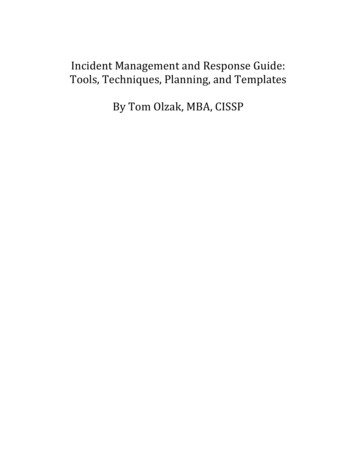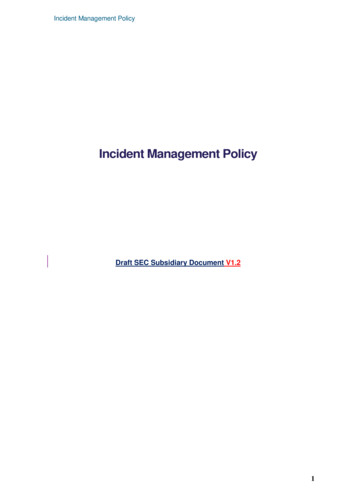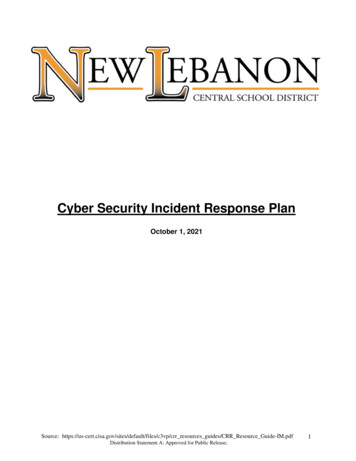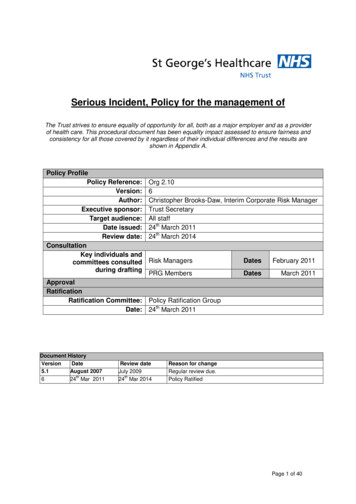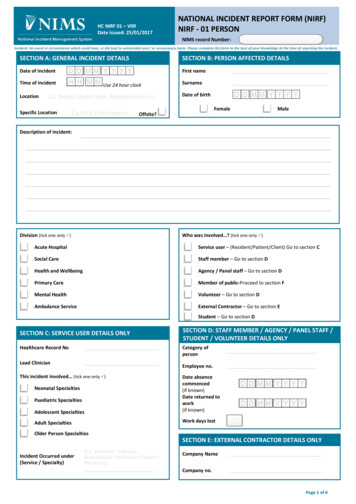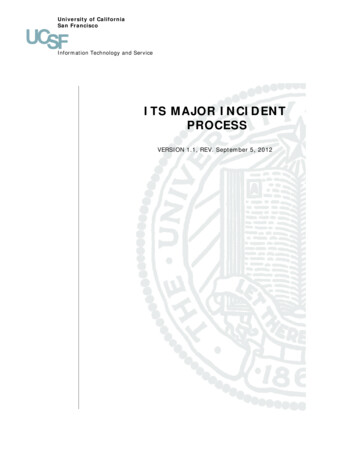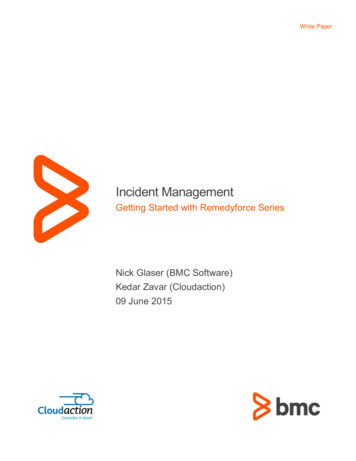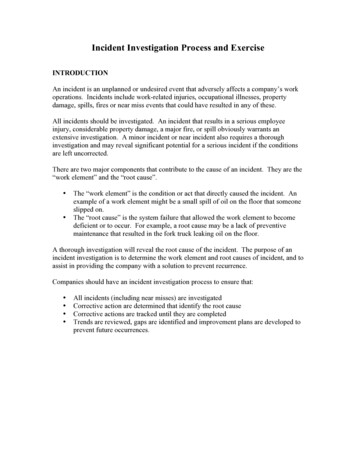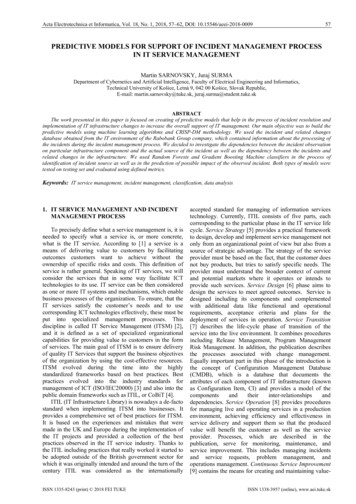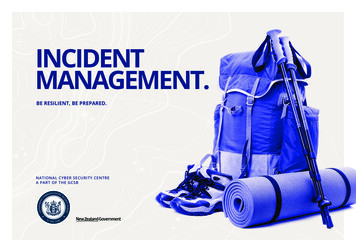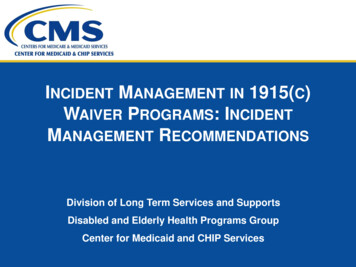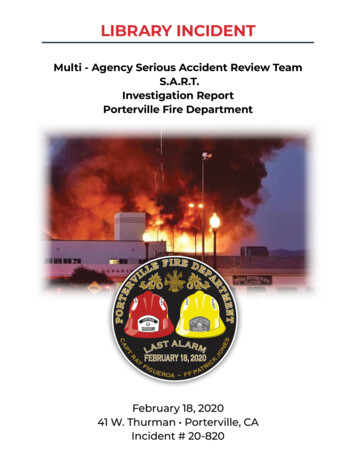
Transcription
LIBRARY INCIDENTMulti - Agency Serious Accident Review TeamS.A.R.T.Investigation ReportPorterville Fire DepartmentFebruary 18, 202041 W. Thurman Porterville, CAIncident # 20-820
Multi – AgencySerious Accident Review TeamLibrary IncidentFinal ReportPorterville Fire DepartmentFebruary 18, 2020Incident # 20-820
Firefighter Patrick Lee JonesPatrick “Jonesy” Jones was born on March 16th, 1994 andreceived his last alarm on February 18th, 2020. He was raised inVisalia, CA and graduated from El Diamanté High School. Heattended Porterville Community College where he completedthe Fire Academy. Patrick was hired with the Porterville FireDepartment as a Reserve Firefighter in 2014 and was offereda part-time firefighter position in 2016. He became a full-timefirefighter in 2017. Patrick was dedicated to being a firefighterattending numerous training opportunities. Patrick was aloving son, a protective little brother, a doting fiancé, and aloyal friend. He was a lover of all things sports (Chargers andPadres) and animals. He loved every single one of the peoplehe worked with and would have done absolutely anything forthem. Patrick’s love for his family was unmatched. Patrick’svibrant personality and infectious smile ensured that no onehe came into contact with was ever a stranger. He loved peopleand people loved him. Patrick’s impact on those around him and his community are a testament to thekind of person he was.Captain Ramon FigueroaRamon “Ray” Figueroa was born January 3, 1985 and receivedhis last alarm on February 18, 2020. He was born and raisedin Delano, CA. He graduated from Delano High School in2003. He attended the Porterville College Fire Academyand graduated in 2006. He began his firefighting career byvolunteering with the Lindsay Fire Department. In 2007, Raywas hired with the Porterville Fire Department as a Firefighter.He was promoted to Engineer in 2016 and Lieutenant in2018. In 2019 he was promoted to Captain. Ray spent the lastthree years as a member of the fire investigation unit. Hewas known for the love of his job and mentoring his crew. Itwas common to hear him say, “My men, the mission, thenme.” He was a devoted and loving father to his two children, adetermined son, a caring brother, and a supportive uncle. Heenjoyed many outdoor adventures, watching sports (Raidersand Dodgers), enjoyed offering his handyman skills to others,spending time with his family and creating many lifelong friendships. He was a lifelong learner andstrived to leave a legacy of hard work and determination.2 SERIOUS ACCIDENT REVIEW TEAM REPORT
Multi-Agency SART MembersMike Kraus, Fire Chief, Retired, Modesto Fire DepartmentChris Ekk, Deputy Chief, Clovis Fire DepartmentCameron Long, Division Chief, Tulare City Fire DepartmentJeff Smith, Division Chief, Tulare County Fire DepartmentBrad Driscoll, Battalion Chief, Fresno Fire DepartmentBryan Cogburn, Battalion Chief, Porterville Fire DepartmentJohn Pepper Jr, Captain, Fresno Fire DepartmentChris Pisani, Captain, Porterville Fire DepartmentDocumentationDumont PrintingSERIOUS ACCIDENT REVIEW TEAM REPORT 3
Table of ContentsForward . . . . . . . . . . . . . . . . . . . . . . . . . . . . . . . . . . . . . . . . . . . . . . . . . . . . . . . . . . . . . . . . . . . . . . . . . . . . . . . . . . . . . . . . . . . . . . . . . . . . 7Description of City/Dept. . . . . . . . . . . . . . . . . . . . . . . . . . . . . . . . . . . . . . . . . . . . . . . . . . . . . . . . . . . . . . . . . . . . . . . . . . . . . . . 9Recognize Fire Chief . . . . . . . . . . . . . . . . . . . . . . . . . . . . . . . . . . . . . . . . . . . . . . . . . . . . . . . . . . . . . . . . . . . . . . . . . . . . . . . . . . 11Recognize Crews . . . . . . . . . . . . . . . . . . . . . . . . . . . . . . . . . . . . . . . . . . . . . . . . . . . . . . . . . . . . . . . . . . . . . . . . . . . . . . . . . . . . . . 11Recognize assisting agencies . . . . . . . . . . . . . . . . . . . . . . . . . . . . . . . . . . . . . . . . . . . . . . . . . . . . . . . . . . . . . . . . . . . . . . . . . 11Acknowledgement of SART Chiefs . . . . . . . . . . . . . . . . . . . . . . . . . . . . . . . . . . . . . . . . . . . . . . . . . . . . . . . . . . . . . . . . . . . . 12Acknowledgement of Supporting Chiefs . . . . . . . . . . . . . . . . . . . . . . . . . . . . . . . . . . . . . . . . . . . . . . . . . . . . . . . . . . . . . 12Porterville Map / Station locations . . . . . . . . . . . . . . . . . . . . . . . . . . . . . . . . . . . . . . . . . . . . . . . . . . . . . . . . . . . . . . . . . . . . 13NIOSH & FFFIPP Summary . . . . . . . . . . . . . . . . . . . . . . . . . . . . . . . . . . . . . . . . . . . . . . . . . . . . . . . . . . . . . . . . . . . . . . . . . . . . . . . 15Executive Summary . . . . . . . . . . . . . . . . . . . . . . . . . . . . . . . . . . . . . . . . . . . . . . . . . . . . . . . . . . . . . . . . . . . . . . . . . . . . . . . . . . . . . . . 19Building Construction / Occupancy . . . . . . . . . . . . . . . . . . . . . . . . . . . . . . . . . . . . . . . . . . . . . . . . . . . . . . . . . . . . . . . . . . . . . 23AerialBuildingUsePhotosMapIncident Overview . . . . . . . . . . . . . . . . . . . . . . . . . . . . . . . . . . . . . . . . . . . . . . . . . . . . . . . . . . . . . . . . . . . . . . . . . . . . . . . . . . . . . . . 35Incident Overview . . . . . . . . . . . . . . . . . . . . . . . . . . . . . . . . . . . . . . . . . . . . . . . . . . . . . . . . . . . . . . . . . . . . . . . . . . . . . . . . . . . 37Horizontal Timeline . . . . . . . . . . . . . . . . . . . . . . . . . . . . . . . . . . . . . . . . . . . . . . . . . . . . . . . . . . . . . . . . . . . . . . . . . . . . . . . . . . 41Body-Camera Video Screenshots . . . . . . . . . . . . . . . . . . . . . . . . . . . . . . . . . . . . . . . . . . . . . . . . . . . . . . . . . . . . . . . . . . . 43Findings and Recommendations . . . . . . . . . . . . . . . . . . . . . . . . . . . . . . . . . . . . . . . . . . . . . . . . . . . . . . . . . . . . . . . . . . . . . . . . 534 SERIOUS ACCIDENT REVIEW TEAM REPORT
Appendices . . . . . . . . . . . . . . . . . . . . . . . . . . . . . . . . . . . . . . . . . . . . . . . . . . . . . . . . . . . . . . . . . . . . . . . . . . . . . . . . . . . . . . . . . . . . . . . 81A. NIOSH FFFIPP Document . . . . . . . . . . . . . . . . . . . . . . . . . . . . . . . . . . . . . . . . . . . . . . . . . . . . . . . . . . . . . . . . . . . . . . . 83B. Bullet recommendations . . . . . . . . . . . . . . . . . . . . . . . . . . . . . . . . . . . . . . . . . . . . . . . . . . . . . . . . . . . . . . . . . . . . . . . . 88C. LettersTraining Letter . . . . . . . . . . . . . . . . . . . . . . . . . . . . . . . . . . . . . . . . . . . . . . . . . . . . . . . . . . . . . . . . . . . . . . . . . . . . . . . . . . . . 95Declaration of Authority . . . . . . . . . . . . . . . . . . . . . . . . . . . . . . . . . . . . . . . . . . . . . . . . . . . . . . . . . . . . . . . . . . . . . . . . . . 97Anticipated Recommendations . . . . . . . . . . . . . . . . . . . . . . . . . . . . . . . . . . . . . . . . . . . . . . . . . . . . . . . . . . . . . . . . . . 98D. IAP . . . . . . . . . . . . . . . . . . . . . . . . . . . . . . . . . . . . . . . . . . . . . . . . . . . . . . . . . . . . . . . . . . . . . . . . . . . . . . . . . . . . . . . . . . . . . . . .99E. Hose Layout Sketch . . . . . . . . . . . . . . . . . . . . . . . . . . . . . . . . . . . . . . . . . . . . . . . . . . . . . . . . . . . . . . . . . . . . . . . . . . . . . . 110F. Related Department Policies . . . . . . . . . . . . . . . . . . . . . . . . . . . . . . . . . . . . . . . . . . . . . . . . . . . . . . . . . . . . . . . . . . . . 111G. Organizational Chart . . . . . . . . . . . . . . . . . . . . . . . . . . . . . . . . . . . . . . . . . . . . . . . . . . . . . . . . . . . . . . . . . . . . . . . . . . . 133H. Photos . . . . . . . . . . . . . . . . . . . . . . . . . . . . . . . . . . . . . . . . . . . . . . . . . . . . . . . . . . . . . . . . . . . . . . . . . . . . . . . . . . . . . . . . . . . 134SERIOUS ACCIDENT REVIEW TEAM REPORT 5
6 SERIOUS ACCIDENT REVIEW TEAM REPORT
FORWARD
FORWARDCity of PortervilleIncorporated in 1902, the City of Porterville is a charter city that operates under the Council-Managerform of government. The City Council is comprised of five members who are elected by their respectivedistricts to serve overlapping four-year terms. Porterville is a full service City, providing Fire, Police, Parksand Leisure Services, Planning, Utilities, and Public Works services to the public. The City Manager isappointed by the City Council, serving as the City’s Chief Executive Officer, and guides the various Citygovernment municipal operations and departments.With a population exceeding 60,000, Porterville is a growing city in the Southern San Joaquin Valley,located midway between San Francisco and Los Angeles. The city contains a wide range of criticalinfrastructure including high speed divided and undivided highways, a municipal airport, 25 schools,one college, four nursing homes, one hospital, six hotels, 41 churches, a large number of commercialenterprises, strip malls, superstores as well as a multitude of multifamily and single family dwellings.Porterville Fire Department OverviewThe Porterville Fire Department is a combination department with 42 career and 15 volunteerfirefighters; operating out of three stations to provide structural and wildland firefighting, rescueoperations, hazardous materials operations and basic life support services. The minimum daily staffingis 10 line personnel with one shift battalion chief. The first alarm structure fire response consists oftwo engines, one ladder truck, one patrol, one Battalion Chief and a mutual aid engine from TulareCounty Fire Department staffed with one person. This initial alarm brings 12 personnel to an incident. Asecond alarm request is a voluntary recall of all off-duty Porterville Fire Department personnel and oneadditional Tulare County Fire engine.The apparatus fleet includes six engines, one Ladder Truck, one rescue, three patrols, five commandvehicles and several other utility support vehicles. In 2019 the department responded to 5,359 incidents,including 369 fires and 100 hazardous materials/condition incidents. The breakdown of fires includes 40structures, 32 vehicles, 112 vegetation fires and 185 other classified fires.Additionally, the Porterville Fire Department provides automatic and mutual aid to its neighboringfire departments within Tulare County totaling another 405,348 residents. They also participate inCalifornia’s Statewide Master Mutual Aid Agreement.SERIOUS ACCIDENT REVIEW TEAM REPORT 9
FORWARDPorterville Fire Department Organizational Staffing HistoryIn 2008, Porterville voters approved Measure H, a one half-cent public safety sales tax increase. Withthose funds, the Porterville Fire Department increased minimum operations staffing (fire personnelwhose main responsibility is to respond to emergency incidents working a 24 hour shift) to seven(7) personnel running out of two (2) stations. At that point in time, operations personnel includedfirefighters, engineers, lieutenants, and captains. Both lieutenants and captains were consideredcompany officers. Each shift had a lieutenant at one station and a captain at the other station. Captainsfunctioned as the shift commander. The department was also staffed with two administrative (40 hourper week) Battalion Chiefs and three administrative (40 hour per week) Captains. The next few yearssaw some minor shuffling of responsibilities for the administrative positions, but no changes to theminimum staffing of operations.In 2015, Porterville Fire Department opened Fire Station 73 . To accommodate this addition, thedepartment added an additional company to operations, increasing minimum operations staffingto 10 personnel. The Company Officer role was handled by a Lieutenant at two of the stations, and aCaptain at the third station functioning as the shift commander. In order to help pay for this increase instaffing, the department eliminated two administrative Captain positions (the Training Captain and thePrevention Captain). Administrative positions that were kept were one Investigation Captain and twoAdministrative Battalion Chiefs (generally considered an Operations Battalion Chief and a PreventionBattalion Chief).The current Fire Chief assumed the position in 2018 and reassigned the responsibilities of theAdministrative Captain from Fire Investigations to Training. In this same year, the voters of Portervilleapproved Measure I, a full-cent general use sales tax increase. The department was still at aminimum staffing of 10 operations personnel, with two (2) Administrative Battalion Chiefs and one (1)Administrative Training Captain. Funds from Measure I were allocated to begin the process of moving tooperations shift Battalion Chiefs. A third Battalion Chief was hired in February 2019 (external candidate)and a fourth Battalion Chief was added in August 2019 (internal promotion). Additionally, the fireprevention function was reorganized with the hiring of a civilian Fire Marshal. Around this same time,the Lieutenants were reclassified to Captains, so each Company Officer was a Captain. With the fourthBattalion Chief addition, each shift had a Battalion Chief as a shift commander, and a minimum staffingof 10 personnel, not including the Chief Officer. There was one administrative Battalion Chief and oneAdministrative Training Captain. This was the organization of the Porterville Fire Department at the timeof the Library Incident.10 SERIOUS ACCIDENT REVIEW TEAM REPORT
FORWARDAcknowledgement of Fire ChiefIn the aftermath of the Library Incident, the Fire Chief had the fortitude to request a Serious AccidentReview Team (SART) to ensure a complete, impartial investigation of this tragic incident. It was theChief’s interest that the loss of these two firefighters not be in vain, and that any lessons that couldbe learned from their deaths might prevent future loss of life during fire ground operations. Heacknowledged that a SART investigation could be painful in that it continues to discuss and relive theevent continuously through the process. However, he recognized that the SART would help in thehealing process, not only for the Porterville Fire Department, but for the families of Captain Figueroa andFirefighter Jones, and for the Fire Service as a whole.Acknowledgement of crews for efforts during the incidentDuring the February 18th incident, nearly all members of the Porterville Fire Department respondedto the second alarm callback request during the incident. This call back assisted by mutual aid fromneighboring agencies, allowed for multiple Rapid Intervention Crews to be lined up to attemptextrication of the downed firefighters. All members present worked to the best of their ability untilrescue efforts were suspended due to unsafe fire and building conditions. Due to the condition of thebuilding, Urban Search and Rescue Task Force Team 5 (RTF-5) and Kern County Urban Search andRescue were requested to assist in locating Firefighter 71.Acknowledgement of assisting agenciesFor nearly two weeks following the incident, agencies from around the valley graciously offered to covershifts for the Fire Department to allow members time to grieve, and to spend time with their families.This generosity exceeds anything that could have been anticipated in an incident of this type, and madeall the difference in assisting the Department during that most difficult time. The Departments thatsent crews to cover, and who provided dedicated service to the community for those weeks include:Calfire Tulare UnitCalfire Madera – Merced – Mariposa UnitTulare County FireFresno City FireFresno County Fire -Calfire Fresno-Kings UnitKern County FireClovis FireKings County FireMerced City FireBakersfield FireKingsburg FireSelma FireSanger FireHanford FireTulare City FireSERIOUS ACCIDENT REVIEW TEAM REPORT 11
FORWARDAcknowledgement of Chiefs sponsoring Multi-Agency SART MembersJohn Binaski, Clovis Fire ChiefCharlie Norman, Tulare County Fire ChiefKerri Donis, Fresno City Fire ChiefLuis Nevarez, Tulare City Fire ChiefAcknowledgement of Supporting ChiefsChief LaPere would like to extend his heartfelt gratitude and thanks to the following Chiefs, whoprovided support and encouragement during the days and weeks following the Library Incident:Chief Charlie Norman, Tulare County FireChief John Binaski, Clovis FireChief Kerri Donis, Fresno City FireAcknowledgement of Porterville City CouncilDuring the SART investigation, members of the team had the opportunity to meet with the PortervilleCity Council to explain and update them on the process. We would like to extend our gratitude to theCouncil for their pledged support and dedication in implementing the recommendations in the longroad to recovery.Martha Flores, MayorMonte Reyes, Vice MayorDaniel Penaloza, Council MemberVirgina Guerrola, Council MemberMilt Stowe, Council MemberAcknowledgment of Porterville City StaffDuring the incident, in the weeks after, and throughout the SART investigation, several city staffmembers have been instrumental in assisting the department move forward and assist with theprocess. We would like to thank them for their hard work and dedication to their fellow coworkers.John Lollis, City ManagerPatrice Hildreth, Deputy City ManagerErik Kroutil, Police ChiefMichael Knight, Public Works DirectorYuliana Andrade, Administrative ServicesRichard Tree, Field Services Manager12 SERIOUS ACCIDENT REVIEW TEAM REPORT
FORWARDCity of Porterville Fire Station LocationsSERIOUS ACCIDENT REVIEW TEAM REPORT 13
14 SERIOUS ACCIDENT REVIEW TEAM REPORT
NIOSH & FFFIPP SUMMARY
NIOSH & FFFIPP SUMMARYSummary of recommendations from the National Institute for Occupational Safetyand Health Fire Firefighter Fatality Investigation and Prevention ProgramDuring the late 1970s and 1980s, the average number of firefighter fatalities in the United States was 125deaths per year. The average number of deaths in the 1990s and 2000s saw an average of 100 deathsannually. Due to these high numbers, Congress has provided funding to the National Institute forOccupational Safety and Health (NIOSH) to implement a firefighter safety initiative. The sole purpose ofthe initiative is to address the problem of firefighter fatalities. With the congressional funding, NIOSHcreated the Firefighter Fatality Investigation and Prevention Program (FFFIPP). The FFFIPP conductsindependent investigations of firefighter line-of-duty deaths (LODD) and offers recommendations toprevent similar deaths in the future.A recent study by the FFFIPP looked at the LODD’s from 2006 to 2014. During the years identified in thestudy, there were 1,067 recommendations made by the FFFIPP in their investigation reports. Of these,784 (73%) could be placed in one of 12 categories. The top 10 recommendation categories overall were:1. Medical screening – annual medical screenings for every firefighter to assess fitness for duty.2. Fitness and wellness program – fitness and wellness programs that enable members to develop andmaintain a level of health and fitness to safely perform their assigned functions.3. Training – an effectively trained workforce.4. Medical clearance – involves whether the firefighter can perform the essential job tasks withoutrisking their lives, their co-workers’ lives, or those of the civilians they are sworn to protect.5. Standard Operating Procedures/Standard Operating Guidelines (SOPs/SOGs) – which are specificdirections for common situations fire personnel will face. They provide all members of a fire departmentwith a common set of enforceable rules to be followed by everyone. SOPs/SOGs should be reviewed,evaluated, and updated periodically and all personnel must be aware of, trained in, and observe the firedepartment’s SOPs/SOGs that should guide actions of firefighters in all types of incidents6. Incident command – incident command which has the overall responsibility of managing theresponse to an incident. The proper utilization and operation of incident command is paramount inkeeping personnel safe and resources effectively engaged in the task at hand and includes life safety,incident stabilization, and property conservation.7. Strategy and tactics – includes strategies such as switching from offensive to defensive tactics,continually evaluating risk versus gain during the incident, and using firefighting tactics such asventilation, water supply, exit routes, safety line use, and searches.8. Communications – encompasses the exchange of information that allows the department to respondappropriately to calls and keep personnel safe on the fireground or incident scene.SERIOUS ACCIDENT REVIEW TEAM REPORT 17
NIOSH & FFFIPP SUMMARY9. Personal protective equipment (PPE) – is vital to protect firefighters when operating on the joband includes the proper use of self-contained breathing apparatus (SCBA) devices (self-containedunderwater breathing apparatus [SCUBA] for those departments with dive teams), personal alert safetysystem (PASS) devices, proper retirement of firefighter turnout gear and wearing and use of proper PPEat MV incidents (retroreflective vests, red wands, flares, cones, etc.).10. Staffing – staffing which addresses issues of having an adequate number of firefighters, adequatedeployment procedures and team continuity.The intent of the FFFIPP is to influence fire departments and firefighters to critically assess and evaluatesituations/circumstances similar to those identified by NIOSH investigations and implement therecommendations offered to prevent additional firefighter fatalities. The high number of medical eventswith the subsequent recommendations underscore the continued need for better medical screening,implementation of fitness and wellness programs, and medical clearance for duty for personnel of firedepartments. Identifying the major traumatic recommendations most frequently made highlightsthe continued need for fire departments to implement training programs and standard operatingprocedures, addressing incident command, fire suppression strategy and tactics, communication,motor-vehicle operation, use of PPE, staffing, and rapid intervention teams. These recommendationsare present in each one of the findings found within the Findings and Recommendations section of thisreport. Only through continued vigilance and addressing hazards facing firefighters will we be able tosee decreased fatalities to this workforce.18 SERIOUS ACCIDENT REVIEW TEAM REPORT
EXECUTIVE SUMMARY
EXECUTIVE SUMMARYExecutive SummaryOn February 18th, 2020, a fire occurred in the City of Porterville Public Library. During the initial minutesof fire department operations, while searching for a reported victim, two members of the first arrivingengine company became disoriented and tragically lost their lives in the line of duty.On April 29th, the Fire Chief issued a Delegation of Authority to a Serious Accident Review Team(SART), authorizing an investigation into the incident. The Chief stated, “It is my hope that the lessonsto be learned from this incident might benefit the entire fire service and result in a safer standard ofoperations for the entire industry.”The SART timeline spanned a nine-month period, utilizing over 1,000 personnel hours. The processincluded the conducting of interviews, analysis of dispatch audios, CAD information, helmet camerafootage, body camera footage, review of policies and procedures, research of laws, mandates, industrystandards, and best practices, as well as regular meetings to comprehend, analyze, organize, andassemble the data into report form.Early in the SART process, the team became aware that a significant number of potential factors were,once again, related to the National Institute of Occupational Safety and Health (NIOSH) Fire FighterInvestigation and Prevention Program (FFFIPP) contributing factors of Firefighter line-of-duty deaths.Consistently the top ten contributing factors, as outlined in their most recent report, are:1. Medical screening2. Fitness and wellness program3. Training4. Medical clearance5. Standard Operating Procedures/Standard Operating Guidelines (SOPs/SOGs)6. Incident command7. Strategy and tactics8. Communications9. Personal protective equipment (PPE)10. StaffingWhile each of the previously listed contributing factors are significant, and continue to remain aproblem in the fire service, the following were the most prevalent during the Library Incident: Training,Standard Operating Procedures/Standard Operating Guidelines (SOPs/SOGs), Incident Command,Strategy and Tactics, Communications, and Staffing.SERIOUS ACCIDENT REVIEW TEAM REPORT 21
EXECUTIVE SUMMARYAs the SART began to de-construct this tragedy, it became evident that other indirect factors were atplay that all Fire Chiefs and Department Administrators should be perceptive to, so as to avoid longterm systemic cultural and operational pitfalls. Vigilance in continual review and comparison to industrystandards, policy updates, establishing relevant and realistic training programs, adjusting emergencydeployment models, and strategically planning for organizational improvement, are some examples ofpreventive measures to avoid cultural complacency and creating an operational road map for the future.This report is not intended to be unduly critical of the Porterville Fire Department or to place blame onany specific person(s). Unfortunately, these issues continue to be far too common across the countryto simply focus on one organization. Until all Fire Service leaders begin to resist complacency andimplement positive change, we will continue to lose our valiant Firefighters. Additionally, Fire Chiefsmust continually educate appointed and elected officials on the importance of sufficient apparatusstaffing. To their credit, the Porterville City Council is presently taking action to increase fire departmentstaffing, even prior to the completion of this document.22 SERIOUS ACCIDENT REVIEW TEAM REPORT
BUILDING CONSTRUCTION
BUILDING CONSTRUCTIONBuilding ConstructionOverviewThe structure involved in this incident is an approximately 19,000 square foot, two story, non-residentialstructure. The occupancy classification of the structure was a mixed use with the majority of thebuilding designated as an A-3 Assembly and also including Educational, Storage, and Businessoccupancy classifications. Since its original construction date the structure was always utilized as apublic library. The original structure was constructed in 1953, with significant additions in 1957 and 1974.1953Original construction, two story, approximately 4,500 square feet. Concrete slab CMU block exterior walls Light steel trusses Composition roofSERIOUS ACCIDENT REVIEW TEAM REPORT 25
BUILDING CONSTRUCTION1957First major addition, single story, approximately 1,600 square feet. Concrete slab CMU block exterior walls (2x4 stud wall, cement plaster exterior, south facing, later opened to the1974 two-story addition) Wood truss framing with plywood sheathing Composition roof26 SERIOUS ACCIDENT REVIEW TEAM REPORT
BUILDING CONSTRUCTIONSERIOUS ACCIDENT REVIEW TEAM REPORT 27
BUILDING CONSTRUCTION1974Second major addition, two story, approximately 12,200 Square feet (6,100 sq. ft. per floor). Concrete slab Concrete block exterior walls Steel Beams Light steel trusses Composition roof28 SERIOUS ACCIDENT REVIEW TEAM REPORT
BUILDING CONSTRUCTIONSERIOUS ACCIDENT REVIEW TEAM REPORT 29
BUILDING CONSTRUCTION30 SERIOUS ACCIDENT REVIEW TEAM REPORT
BUILDING CONSTRUCTIONThis colored diagram represents the Porterville Library’s three phases of major construction.ALPHADELTABRAVOCHARLIESERIOUS ACCIDENT REVIEW TEAM REPORT 31
BUILDING CONSTRUCTIONSite InformationThe Porterville Public Library was directly north of Porterville Fire Station 71, the two structures were onthe same parcel. To the east of the Library was the Porterville City Hall. This building is directly acrossN. Division St. which functions as more of an alley between the two buildings. The Porterville PoliceDepartment is northwest of the library. Directly to the north of the library, across W. Thurman Ave. is alarge parking lot serving Bank of America to the east. To the west, there is a building containing severalsmall businesses and a two-story residential structure that is no longer used for residential purposes.ALPHADELTABRAVOCHARLIE32 SERIOUS ACCIDENT REVIEW TEAM REPORT
BUILDING CONSTRUCTIONFire Department Pre-PlanBelow you will find the Porterville Public Library Pre-fire Plan which is kept in a binder on eachfire engine to be used in emergency situations. This plan is periodically updated to ensure that allinformation is correct.The first page lists the business name and address along with emergency contact information. It has asmall overview map showing the location and how it relates to the surrounding area. The map providesthe street names and the location of the closest hydrants along with their water capabilities in gallonsper minute(GPM). It has a small amount of construction information with the estimated square footageof the building and the type of construction and materials used for the roof, walls, and floor. It also liststhe initial fire attack water flow and total flow needed for a fire in gallons per minute. The pre plan listsany known special conditions or hazards.(Personal information redacted from image. Drawing not to scale)SERIOUS ACCIDENT REVIEW TEAM REPORT 33
BUILDING CONSTRUCTIONThe second page is a detailed map of the interior. This map shows the room layout, doorways,hallways, stairwells, and elevators. It also shows the location
one college, four nursing homes, one hospital, six hotels, 41 churches, a large number of commercial enterprises, strip malls, superstores as well as a multitude of multifamily and single family dwellings. Porterville Fire Department Overview The Porterville Fire Department is a combination department with 42 career and 15 volunteer
